What woodpeckers can you see in France? There are 9 different species of woodpecker that you might encounter in France. Read this article to see pictures, hear their sound and get great information about where and when you can spot all woodpeckers in France.
France isn’t just about the Eiffel Tower and croissants; it’s a haven for nature lovers, especially those with a penchant for birds. And if you’re into woodpeckers, mon ami, you’re in for a treat. These feisty birds have found themselves quite the home amidst the French trees, and spotting them can be a delightful addition to any trip.
Let’s jump into the article.
1. Eurasian Three-toed Woodpecker
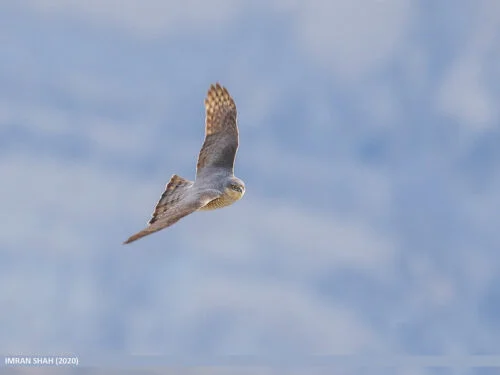
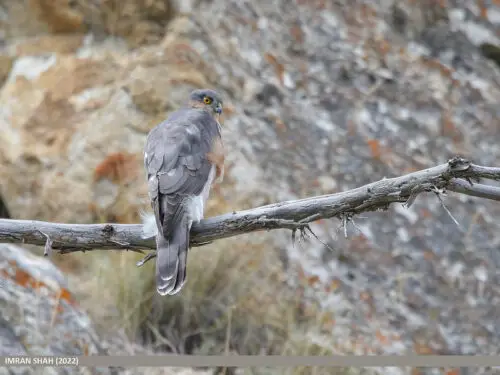
We start off the list with a rare species.
Venturing into the serene woodlands of France, you might chance upon the cryptic Eurasian Three-toed Woodpecker, a bird that certainly stands out, not for its vibrant colors, but for its unique anatomy and habitat preference.
As its name indicates, this woodpecker is distinct due to its three toes – a configuration of two pointing forward and one backward. This is unlike the majority of woodpeckers, which proudly display four. Clothed primarily in black and white, males possess an additional splash of color with a yellow cap that adds a regal touch to their appearance.
In terms of habitat, the Eurasian Three-toed Woodpecker has a penchant for coniferous forests, often in higher altitudes. Within these quiet, needle-covered sanctuaries, they embark on their relentless search for insects, especially bark beetles, a favorite snack. Their presence in a forest can often indicate a healthy ecosystem, as they tend to thrive where there’s a balance of old and new growth.
Their drumming is less frequent than other woodpeckers, which often makes their discovery even more rewarding. When they do drum, it’s usually a rapid series, sounding almost like a fast-paced roll on a snare drum.
For those with a keen interest in spotting this intriguing bird, heading to the elevated terrains of the French Alps or the Pyrenees would be ideal. Here, amid the towering trees and the fresh mountain air, the Eurasian Three-toed Woodpecker goes about its day, a symbol of nature’s wonderful quirks and adaptations.
2. Middle Spotted Woodpecker
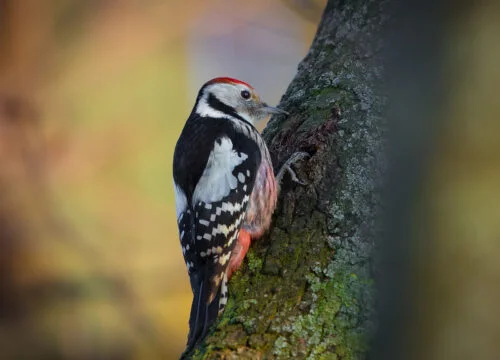
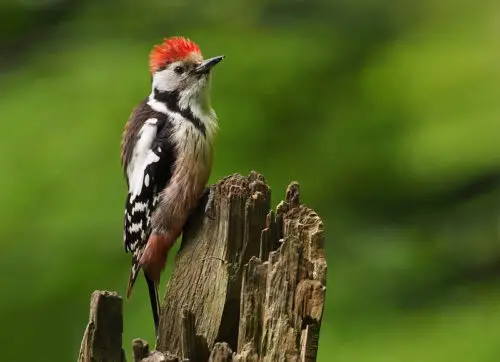
Hidden within the luscious French woodlands, the Middle Spotted Woodpecker is a delightful avian marvel that adds an extra layer of charm to any bird-watching excursion.
With a size that’s just right, not too large nor too tiny, it stands out with a pinkish-white belly that gives it a touch of warmth and color. Complementing this are its brown back and wings, speckled gracefully in white, evoking a sense of natural mosaic artistry.
The males, always trying to be a tad more flamboyant, wear a brilliant red crown atop their heads, making them just a bit more noticeable than their female counterparts.
The broad-leaved forests of France, particularly those rich in oak, are where the Middle Spotted Woodpecker feels most at home.
These woody havens offer a plethora of insects, which form the bulk of their diet. However, never ones to pass up a good opportunity, they will also enjoy seeds and occasionally even fruits, proving they have a varied palate.
Their drumming, a staple among woodpecker species, is characterized by its rapid tempo, but it remains softer and somewhat more subdued than that of the Great Spotted Woodpecker.
This can make them a bit elusive, but for the patient observer, the payoff is certainly worth the wait.
If you wish to catch a glimpse of this speckled beauty, regions like Champagne or the verdant Loire Valley are excellent places to start.
As you venture through these regions, keep an ear out for the woodpecker’s distinct drumming and an eye out for a flutter of wings dappled in brown and white.
In sum, the Middle Spotted Woodpecker encapsulates the essence of France’s lesser-known natural treasures: understated, beautiful, and waiting for those with a keen eye and heart to discover.
3. White-backed Woodpecker
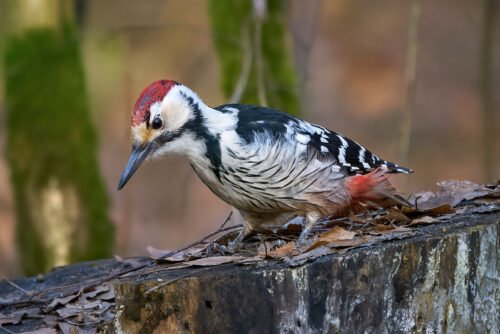
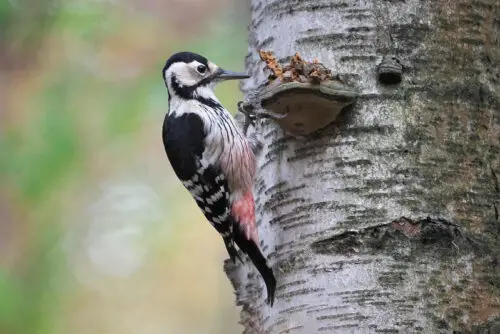
Amidst the rich tapestry of European avifauna, the White-backed Woodpecker shines as a symbol of nature’s elegance and the mysteries concealed within the deep forests of France.
Gracefully adorned, the White-backed Woodpecker’s defining feature is its luminescent white underbelly, which contrasts strikingly with the black-and-white barred pattern gracing its wings and back. Males, always keen on a touch of drama, also showcase a vibrant red cap, making them easy to distinguish from the more demure females.
This particular woodpecker species holds a special fondness for ancient deciduous forests, where old trees and ample deadwood provide a haven and a hunting ground.
Beech and oak woods, with their timeless grandeur and rich biodiversity, are their favored domains.
Within these woods, the White-backed Woodpecker’s diet revolves primarily around insects, with a penchant for wood-boring beetles.
Their drumming, a rhythmic and resonant testament to their presence, often reverberates through the stillness of the forest, inviting keen birdwatchers to trace its source and witness the bird’s subtle beauty.
If your wanderlust ever draws you towards the more pristine and untouched regions of France, the eastern parts near the Alps would be your best bet to encounter this elusive woodpecker.
Here, beneath the canopy of old-growth trees and amidst the symphony of forest sounds, the White-backed Woodpecker continues its timeless dance with nature.
To behold this bird is to be reminded of the hidden gems that await discovery for those willing to tread the path less traveled, deep into the heart of France’s wilderness
4. Great Spotted Woodpecker
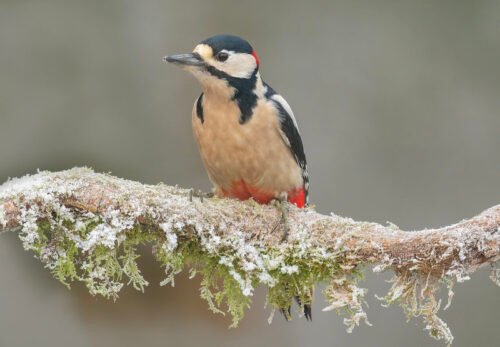
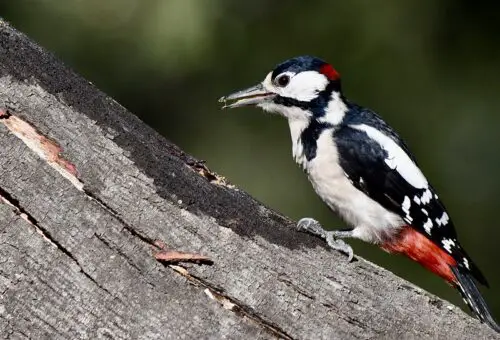
Deep within the diverse woodlands of France, the rhythmic drumming of the Great Spotted Woodpecker often serves as nature’s metronome, marking time in a world where hours and minutes lose their meaning.
At first glance, this bird captivates with its striking appearance.
Dressed primarily in bold black and white patterns, its plumage resembles a monochrome mosaic. But, as with many things in nature, there’s an unexpected burst of color: a vivid crimson patch under the tail and, for males, a brilliant red spot on the back of the head.
Its preferred domain spans across a variety of woodlands, from deciduous forests rich in oak and beech to coniferous expanses.
These habitats offer a rich menu of insects, seeds, and sap, satisfying the diverse culinary preferences of this adaptable woodpecker.
Drumming, a distinct behavior of woodpeckers, is not just a musical endeavor for the Great Spotted Woodpecker. It serves as a means of communication, demarcating territory, or attracting a mate.
The sound, resembling a rapid burst of taps, can often be heard resonating through the forest, an open invitation for bird enthusiasts to trace its source.
If you’re on a quest to encounter this magnificent bird within France, you’re in luck.
Its widespread distribution means that from the verdant forests of Normandy to the rugged landscapes of the Pyrenees, an encounter with the Great Spotted Woodpecker is always within reach.
In essence, this bird symbolizes the vibrant heartbeat of the French woodlands, a constant and reassuring presence in an ever-changing environment. The next time you’re wandering through a French forest and hear that iconic drumming, take a moment to appreciate the natural rhythms and the bird that brings them to life.
5. Lesser Spotted Woodpecker
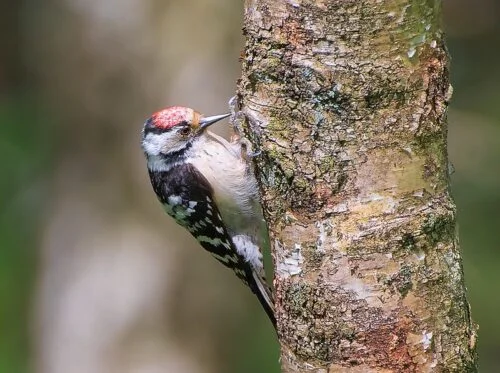
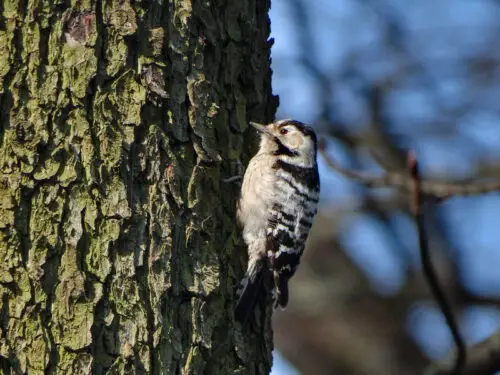
Nestled within the leafy expanses of France’s varied woodlands, the Lesser Spotted Woodpecker is a testament to the beauty that often resides in the smaller details of nature.
Deceptively named, this “lesser” woodpecker is in no way inferior to its peers; it simply refers to its petite size. Wrapped in an elegant garb of black and white, its delicate frame is accentuated by the dappling on its wings and back. For those fortunate enough to spot a male, the crown reveals a delightful splash of crimson, adding a touch of flamboyance to an otherwise understated appearance.
The Lesser Spotted Woodpecker, true to its affinity for trees, has a predilection for older deciduous forests, where aged wood offers a veritable feast of insects. Whether it’s hunting larvae from beneath the bark or tapping away in its gentle rhythm, this bird is a master of its craft.
The drumming of the Lesser Spotted Woodpecker is softer and more restrained when compared to its larger counterparts. However, this subtlety makes each auditory encounter with them even more special. Its presence in a forest is akin to a whisper amidst shouts, compelling and drawing attention precisely because of its gentleness.
For those with a desire to witness this avian delight in France, the sprawling forests of regions like Alsace or Burgundy, with their ancient trees and rich biodiversity, offer a promising backdrop.
To encounter the Lesser Spotted Woodpecker is to be reminded of the profound beauty that lies in simplicity and to appreciate the delicate balance of nature that thrives in the heart of France’s woodlands. In a world that often celebrates the loud and grand, this diminutive woodpecker stands as a symbol of the enchanting allure of the understated.
6. Grey-headed Woodpecker
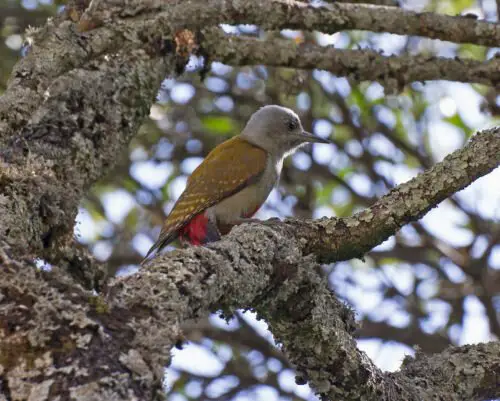
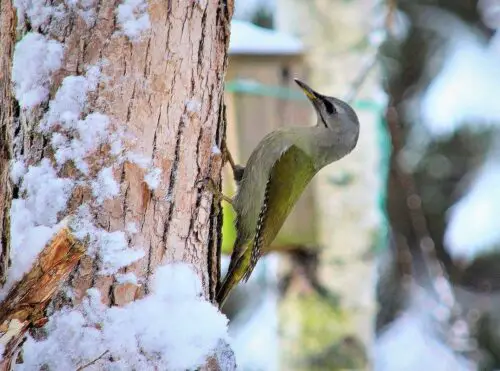
The Grey-headed Woodpecker is a subtly adorned bird, a quiet gem among its more colorful counterparts. With a soft greenish-grey head paired with green upperparts, this bird is a lesson in understated elegance.
Its pale undersides provide a contrasting base, giving it an almost ethereal appearance, especially when spotted against the deep greens of a dense forest.
Found mainly in mixed and deciduous forests, these birds are more discreet in their behavior, often staying away from the limelight. This makes spotting them a genuine treat for keen birdwatchers.
Their diet is predominantly insectivorous, but they’ve also been known to munch on some plant material, diversifying their meals like a true French gourmand.
While their drumming is a part of their repertoire, they aren’t as vocal or persistent drummers as some of the other woodpeckers. This adds to their elusive nature, making each sighting or sound even more rewarding.
If you’re keen to spot the Grey-headed Woodpecker, eastern France, particularly regions bordering Germany and Switzerland, would be a good starting point. The dense forests here provide an ideal habitat for these birds, offering both food and shelter.
In essence, the Grey-headed Woodpecker embodies the spirit of quiet, rustic France – a world away from the bustling tourist spots, waiting to be discovered by those who seek it.
7. Eurasian Green Woodpecker
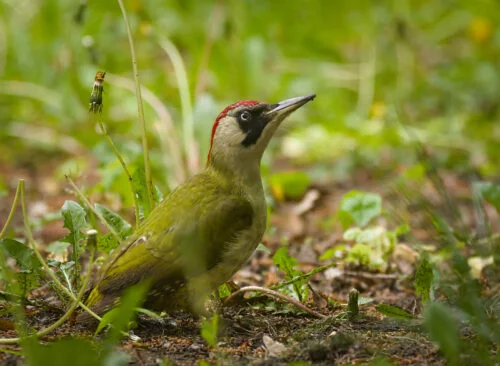
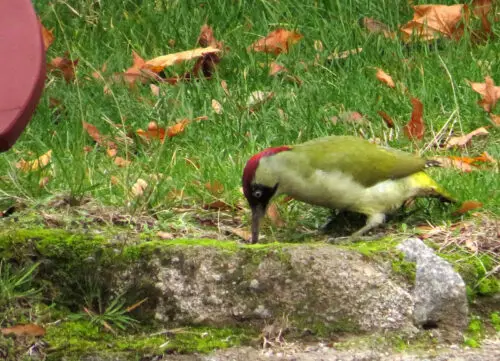
In the diverse avian world of France, the Eurasian Green Woodpecker emerges as a brilliant splash of color amidst the verdant landscape, a lively brushstroke on nature’s canvas.
Boasting a vibrant green plumage that seems to merge seamlessly with the foliage, this woodpecker is the embodiment of the forest’s spirit. Its belly showcases a soft, pale hue, but it’s the vivid crimson crown and black moustache-like streaks (with a hint of red in males) that truly accentuate its distinctive appearance.
The Eurasian Green Woodpecker has an intriguingly varied diet, with ants reigning supreme as its meal of choice. Using its long, sticky tongue, it deftly extracts these insects from their nests, proving that the forest floor can be as bountiful as the tree canopy.
Unlike many of its woodpecker counterparts, this bird’s drumming is less pronounced. Instead, its presence is often announced by a loud, laughing call, earning it folklore titles in various cultures, such as the “yaffle.”
Found predominantly in open woodlands, grasslands with scattered trees, and even large gardens, this woodpecker enjoys the bounty of both trees and the earth. France’s diverse regions, from the sun-kissed plains of Provence to the rolling hills of the Dordogne, are prime territories for witnessing this bird in action.
Encountering the Eurasian Green Woodpecker is akin to discovering a living gem, a reminder of the vibrant life that pulses through the French countryside. It’s an invitation to pause, listen, and marvel at the wonders of the natural world, beautifully harmonized in the form of this charismatic bird.
8. Iberian Green Woodpecker
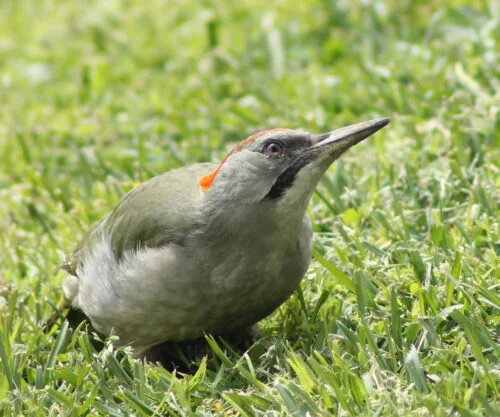
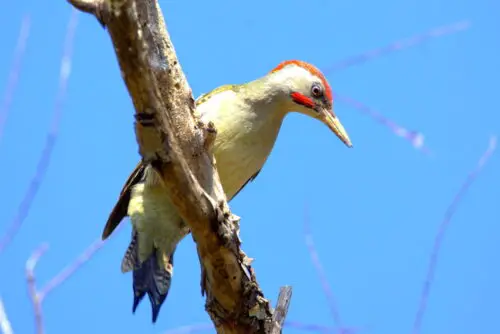
Deep within the mosaic of Europe’s avian life, the Iberian Green Woodpecker stands out as a testament to regional adaptation and the rich biodiversity found on the Iberian Peninsula, including parts of southern France.
A close cousin of the more widespread Eurasian Green Woodpecker, the Iberian Green Woodpecker is equally captivating in appearance but possesses certain distinctions that mark it as unique. Adorned in shades of olive-green, this bird subtly blends into its woodland surroundings. What truly sets it apart, however, is the lack of a black mustache mark, which is prominent in its Eurasian relative. Additionally, the red crown which is more extensive in males, and a hint of pale ivory on its belly add to its distinguishing features.
The Iberian Green Woodpecker, like its close relative, has a particular fondness for ants. With a tongue adeptly designed for the task, this woodpecker can be found foraging on the ground, skillfully extracting ants and their larvae from the earth. Their presence is often given away not just by their vibrant color but also by their distinct calls which echo through the woodlands.
Given its name and primary range, this woodpecker is predominantly found on the Iberian Peninsula. However, parts of southern France, especially regions close to the Pyrenees, also offer a chance to witness this bird, where it thrives in deciduous and mixed forests.
Spotting the Iberian Green Woodpecker is a delightful experience for nature enthusiasts and birdwatchers alike, symbolizing the subtle variations and adaptations that nature crafts over time. In the quiet corners of southern France, where the mountains kiss the sky and ancient forests whisper tales of old, the Iberian Green Woodpecker plays its part in the grand tapestry of life.
9. Black Woodpecker
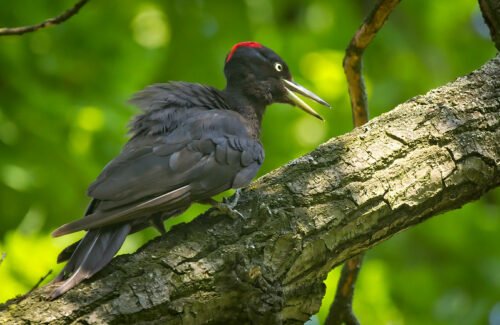
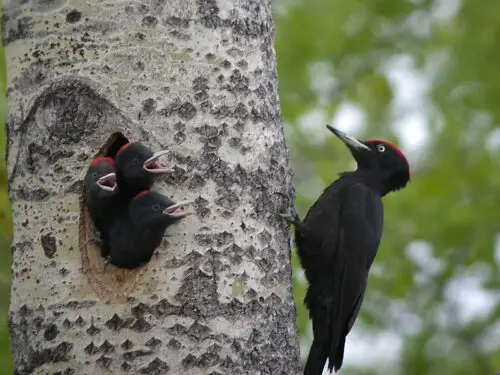
In the vast orchestra of woodland sounds, the Black Woodpecker’s drumming emerges as a powerful and unmistakable solo. One of Europe’s largest woodpeckers, this majestic bird is a sight to behold and a sound to be heard throughout various parts of France.
Cloaked in a deep, velvety black, the Black Woodpecker’s plumage stands in stark contrast to the often-green backdrop of its habitat. The male showcases an arresting scarlet crown, giving him an almost regal appearance. Females, while sharing the same deep black hue, have a more subdued head color, allowing for easy gender identification.
Preferring mature forests, especially those rich in conifers or mixed woodlands, the Black Woodpecker carves out large cavities in dead or dying trees for nesting. These cavities, once abandoned by the woodpecker, often become valuable nesting sites for other birds and creatures, underscoring the Black Woodpecker’s role as a keystone species in its ecosystem.
With a diet primarily composed of insects, especially wood-boring beetles and their larvae, the Black Woodpecker is a forest’s natural pest control. Their loud, resonant drumming, which can sometimes be mistaken for the sound of an axe at work, marks their territory and communicates with potential mates.
France’s more extensive, undisturbed forests, especially those in regions such as the Vosges, Jura, and the French Alps, offer the best opportunities to witness this magnificent bird in its natural environment.
The Black Woodpecker’s presence in France’s woodlands is more than just a visual or auditory treat; it’s a testament to the health and vitality of the ecosystem. To see and hear this bird is to know that the forest is alive and thriving, echoing with the rhythms of nature that have persisted for millennia.
